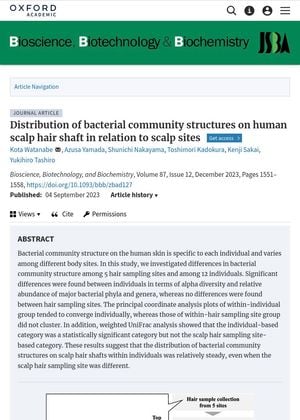Distribution of Bacterial Community Structures on Human Scalp Hair Shaft in Relation to Scalp Sites
September 2023
in “
Bioscience, biotechnology, and biochemistry
”

TLDR Bacterial communities on scalp hair are unique to each person but consistent across different scalp sites.
This study examined the bacterial community structure on scalp hair shafts from 5 different sites on the scalp of 12 individuals. Significant differences in bacterial diversity and abundance were observed between individuals, but not between different scalp sites. Principal coordinate analysis showed that bacterial communities clustered by individual rather than by scalp site. Weighted UniFrac analysis confirmed that individual differences were statistically significant, while differences between scalp sites were not. These findings suggest that the bacterial community structure on scalp hair shafts is consistent within individuals, regardless of the specific scalp site sampled.





